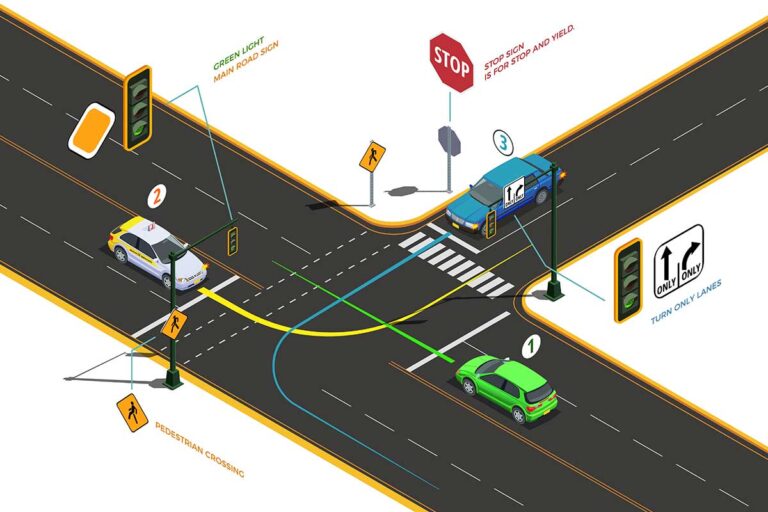Demystifying Georgia’s Right of Way Laws
When it comes to driving in Georgia, understanding right of way laws is critical—not only for avoiding traffic citations but also for preventing serious accidents. These laws delineate which driver, cyclist, or pedestrian has the legal privilege to proceed in various traffic scenarios, significantly reducing the potential for accidents. However, mere knowledge of these rights is not sufficient; exercising caution and courtesy is equally vital. Drivers should prioritize yielding the right-of-way to others instead of simply claiming it.
Misunderstanding or ignoring who has the right of way can lead to catastrophic collisions, especially at intersections, crosswalks, and highway merges. As a personal injury law firm committed to representing accident victims, The Jewkes Firm wants Georgia drivers to stay informed and protected. Below, we break down the key elements of Georgia’s right of way laws and what to do if you’ve been involved in a collision.
What is Right of Way?
Right of way refers to the legal right of a driver, pedestrian, or cyclist to proceed in a certain direction or at an intersection without yielding to other vehicles or pedestrians. It does not mean someone “owns” the road, but rather it dictates the order in which drivers and others must yield to prevent conflict and ensure safety. While Georgia law clearly defines who has the right-of-way, it is crucial to acknowledge that even if one is legally justified in their actions, yielding to avoid collisions is always the safer choice. Understanding right of way laws is crucial for ensuring safety on the roads and preventing accidents.
Categories of Right of Way
In the state of Georgia, it’s important for drivers to familiarize themselves with several key types of right of way. The general principle is that the first vehicle to reach an intersection has the right of way; however, several exceptions exist. For instance, pedestrians always take precedence when crossing at designated crosswalks, even if a traffic signal indicates otherwise. Cyclists also have specific rights, such as being allowed to occupy a full lane and being prioritized in bike lanes.
Moreover, emergency vehicles—like ambulances and fire trucks—have the right of way when their sirens and lights are activated. In such situations, drivers must pull over and stop until the emergency vehicle has safely passed.
Right of Way at Intersections
Intersections often pose ssignificant confusion regarding right of way regulations. At a four-way stop, the vehicle that arrives first has the priority. In cases where two vehicles reach the intersection simultaneously, the driver on the right gets to go first. In roundabouts, vehicles already circulating within the roundabout have precedence over those entering. At uncontrolled intersections, the driver on the right again holds the right of way.
Traffic signals also play a vital role in right of way. A driver facing a green light has the right of way; however, if two vehicles arrive at a green light at the same time, the vehicle on the right takes priority. Unique situations, such as funeral processions, may create additional right of way considerations at intersections.
Right of Way on Georgia Roads
Georgia’s roadways come with their own set of right of way rules. Generally, drivers must yield to pedestrians and cyclists. On multi-lane roads, it is important to yield to vehicles changing lanes. On one-way streets, drivers must yield to those making left turns. Additionally, on divided highways, drivers should yield the right of way to vehicles entering or leaving the highway. Rural roads often require drivers to yield to those passing on the left.
Injured In A Car Wreck? Contact Us For A Free Consultation
Injured In A Car Wreck?

Georgia Right of Way Laws — Common Scenarios
Georgia’s right of way laws are primarily outlined in the Official Code of Georgia Annotated (O.C.G.A.) § 40-6-70 through § 40-6-77. Several common scenarios illustrate the application of right-of-way laws on Georgia roads:
Controlled Intersections
At intersections with traffic signals or stop signs, the rules are straightforward. Drivers must obey the signals. For example, a red light means stop, while a green light allows for proceeding through the intersection.
Uncontrolled Intersections
At intersections without signs or signals, drivers on the left must yield to those on the right when both arrive simultaneously. In four-way stop situations, vehicles must proceed in the order of arrival.
Roundabouts
In Georgia, vehicles inside a roundabout have the right of way over those entering the roundabout. Drivers must yield to traffic already circulating within the roundabout, ensuring a smooth flow of traffic and reducing the likelihood of collisions.
Traffic Signals
Even with a green light, it is imperative to check that the intersection is clear of vehicles and pedestrians before proceeding.
Left Turns
When making a left turn, drivers must yield to oncoming traffic going straight or turning right unless they have a dedicated left turn signal. This is essential for avoiding accidents at intersections.
Stop Signs
At a stop sign, drivers must come to a complete stop and yield to any other vehicles or pedestrians already in the intersection.
Yield Signs
Upon reaching a yield sign, drivers must reduce speed and be prepared to stop, ensuring that the way is clear before entering or crossing the roadway.
Merging into Traffic
Ensure that you adjust your speed and position for a safe entry into traffic. If another vehicle is merging into your lane, either create space or reduce speed to facilitate their safe entry.
Highway Merges
Vehicles merging onto a highway must yield to those already on the road. Motorists currently traveling on the highway have the right of way. Merge safely and politely.
Entering from Private Roads
When merging onto a public road from a private driveway or alley, you must stop and yield to any existing traffic on the roadway.

Special Considerations in Georgia
O.C.G.A. § 40-6-72 – Yielding at Intersections
This statute mandates that drivers yield to vehicles already in the intersection or those that pose an immediate hazard. Failure to yield can result in fines and legal liability in the event of an accident.
Special Situations Requiring Extra Caution
Certain situations necessitate heightened awareness of right-of-way rules to ensure public safety:
- Pedestrians. Pedestrians have the right of way at crosswalks, whether marked or unmarked.
Drivers must yield to pedestrians crossing the street, and failure to do so can result in serious legal consequences, including liability in personal injury claims. - Emergency Vehicles. Georgia law requires drivers to yield the right of way to emergency vehicles (such as an ambulance, fire truck, or police car) using sirens or flashing lights. Move to the right side of the road and remain stopped until the emergency vehicle has passed.
- Construction Zones. Drivers must give way to construction workers and equipment in highway work zones. Slow down and remain vigilant for potential stops.
- School Buses. Georgia law mandates that all vehicles must stop for school buses that are picking up or dropping off children. It is illegal to pass a bus displaying flashing red lights and extended stop signs. The purpose of this legislation is to protect children getting on and off the bus.

Consequences of Right of Way Violations
Failing to adhere to right of way laws can have significant consequences. Depending on the nature of the violation, offenders may face fines and points on their driving record. In severe cases, especially if an accident occurs resulting in injury or fatalities, drivers could face criminal charges. Violating right of way laws can lead to serious consequences, including:
- Traffic Citations. Drivers who fail to yield the right of way may receive a traffic ticket, which can result in fines and points on their driving record.
- Accidents. Failing to yield can lead to collisions, resulting in injuries to drivers, passengers, and pedestrians.
- Legal Penalties. In serious instances, including accidents that lead to significant injuries or fatalities, breaching right-of-way regulations may lead to criminal prosecution or liability in personal injury claims.
Comparative Negligence in Georgia
Georgia follows a modified comparative negligence rule. If you are determined to be 50% or more at fault, you cannot claim damages. Misunderstanding right of way could potentially reduce or eliminate your compensation in a personal injury claim.
Why Right of Way Violations Lead to Personal Injury Cases
Right of way violations are among the top causes of traffic collisions in Georgia. These violations often result in:
- T-bone collisions at intersections
- Pedestrian injuries in crosswalks
- Merging accidents on highways
- Motorcycle and bicycle crashes due to failure to yield
These cases can involve serious injuries like traumatic brain injury, spinal cord damage, broken bones, or even wrongful death.
Need a Free Consultation? Need a Skilled Attorney?
Free Consultation
Call (770) 771-5130
If you’ve been injured, you need to hire the best legal care to assist you with your claim. Get a FREE consultation today!
What To Do If You’ve Been Injured in a Right of Way Accident
If you’ve been injured due to another driver’s failure to yield, take these steps:
- Call 911 – Report the accident and get medical assistance.
- Document the scene – Take photos, note traffic signals, and collect witness statements.
- Get medical help – Even if you feel fine, it’s important to get checked out.
- Avoid admitting fault – Let the investigation determine responsibility.
- Contact a personal injury attorney – An experienced lawyer can help protect your rights and maximize your compensation.
How The Jewkes Law Firm Can Help
At The Jewkes Firm, we understand the life-altering impact a car accident can have on you and your family. Led by Attorney Jordan Jewkes, we bring compassion, legal experience, and a proven track record to every case. We will:
- Investigate the accident thoroughly
- Establish fault under Georgia’s right of way and traffic laws
- Negotiate with insurance companies
- Fight for maximum compensation for medical bills, lost wages, and pain and suffering
Understanding Georgia’s right-of-way laws is crucial for ensuring a safe and accident-free driving experience. Always prioritize yielding to pedestrians and cyclists, obey traffic signals, and stay informed about right of way rules at intersections and on roads.
Right of way laws exist to keep our roads safe. Unfortunately, not every driver follows them—and when they don’t, the consequences can be devastating. If you or someone you love has been injured in a right of way accident, you don’t have to navigate the legal system alone. Call The Jewkes Firm today at (770) 771-5130 to schedule your free consultation.

GEORGIA PERSONAL INJURY LAWYER NEAR ME
Frequently Asked Questions
What does "right of way" mean in Georgia?
The right of way in Georgia refers to the legal right of a vehicle or pedestrian to proceed in a certain direction or at an intersection without yielding to others. It is crucial for maintaining traffic order and safety.
Do pedestrians always have the right of way in Georgia?
Yes, Georgia law requires drivers to yield to pedestrians in both marked and unmarked crosswalks. You need to be extra careful in school zones and places where there are crossing guards.
Who has the right of way at a 4-way stop in Georgia?
The vehicle that arrives first at an intersection holds the right of way. In instances where two vehicles reach the intersection simultaneously, priority is given to the driver on the right. At intersections without traffic control measures, the vehicle on the right takes precedence. When two vehicles arrive at the same time, it is mandatory for the driver on the left to yield to the motorist on the right.
What should I do if I'm involved in an accident due to a right of way violation?
If you’re involved in an accident, it’s important to gather evidence, document the scene, and seek medical attention if needed. Contact a personal injury attorney, like those at The Jewkes Firm, to discuss your case and explore your legal options.
What are the rules regarding right turns in Georgia?
Drivers must signal their intent to turn right at least 100 feet in advance. When executing a right turn, vehicles should stay as close to the right curb as possible. Turning right on a red light is permissible unless otherwise indicated by signage, provided drivers come to a complete stop and yield to other traffic and pedestrians.
What happens if someone fails to yield the right of way in Georgia?
Failure to yield can result in citations, insurance liability, and legal responsibility for any accidents caused. You may also be found at fault in a personal injury claim.
What happens if I cause an accident by violating right of way laws?
If your actions lead to an accident, you may be liable for any resulting injuries or damages, and could face legal action depending on the incident's severity.





